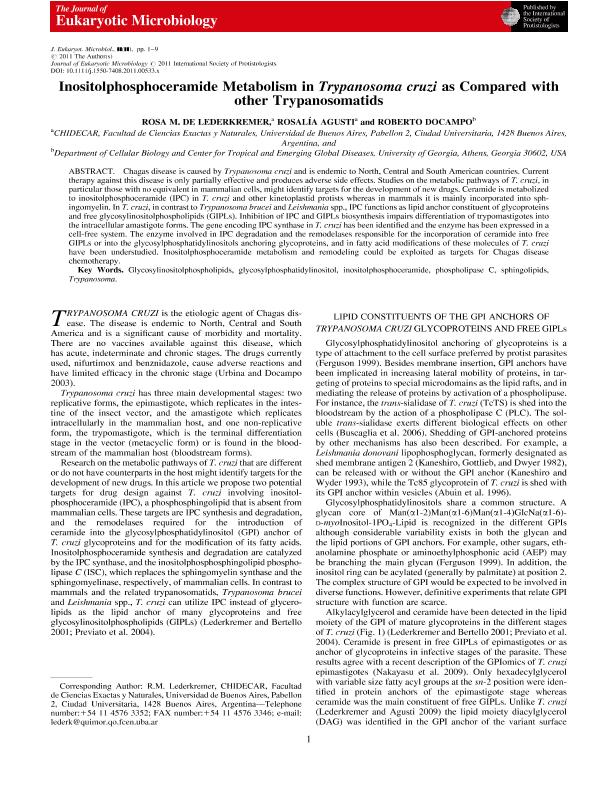Mostrar el registro sencillo del ítem
dc.contributor.author
Muchnik, Rosa

dc.contributor.author
Agusti, Rosalia

dc.contributor.author
Docampo, Roberto
dc.date.available
2019-01-28T20:19:20Z
dc.date.issued
2011-03
dc.identifier.citation
Muchnik, Rosa; Agusti, Rosalia; Docampo, Roberto; Inositolphosphoceramide metabolism in Trypanosoma cruzi as compared with other trypanosomatids; Wiley Blackwell Publishing, Inc; Journal of Eukaryotic Microbiology; 58; 2; 3-2011; 79-87
dc.identifier.issn
1066-5234
dc.identifier.uri
http://hdl.handle.net/11336/68818
dc.description.abstract
Chagas disease is caused by Trypanosoma cruzi and is endemic to North, Central and South American countries. Current therapy against this disease is only partially effective and produces adverse side effects. Studies on the metabolic pathways of T. cruzi, in particular those with no equivalent in mammalian cells, might identify targets for the development of new drugs. Ceramide is metabolized to inositolphosphoceramide (IPC) in T. cruzi and other kinetoplastid protists whereas in mammals it is mainly incorporated into sphingomyelin. In T. cruzi, in contrast to Trypanosoma brucei and Leishmania spp., IPC functions as lipid anchor constituent of glycoproteins and free glycosylinositolphospholipids (GIPLs). Inhibition of IPC and GIPLs biosynthesis impairs differentiation of trypomastigotes into the intracellular amastigote forms. The gene encoding IPC synthase in T. cruzi has been identified and the enzyme has been expressed in a cell-free system. The enzyme involved in IPC degradation and the remodelases responsible for the incorporation of ceramide into free GIPLs or into the glycosylphosphatidylinositols anchoring glycoproteins, and in fatty acid modifications of these molecules of T. cruzi have been understudied. Inositolphosphoceramide metabolism and remodeling could be exploited as targets for Chagas disease chemotherapy.
dc.format
application/pdf
dc.language.iso
eng
dc.publisher
Wiley Blackwell Publishing, Inc

dc.rights
info:eu-repo/semantics/openAccess
dc.rights.uri
https://creativecommons.org/licenses/by-nc-sa/2.5/ar/
dc.subject
Glycosylinositolphospholipids
dc.subject
Glycosylphosphatidylinositol
dc.subject
Inositolphosphoceramide
dc.subject
Phospholipase C
dc.subject
Sphingolipids
dc.subject
Trypanosoma
dc.subject.classification
Otras Ciencias Químicas

dc.subject.classification
Ciencias Químicas

dc.subject.classification
CIENCIAS NATURALES Y EXACTAS

dc.title
Inositolphosphoceramide metabolism in Trypanosoma cruzi as compared with other trypanosomatids
dc.type
info:eu-repo/semantics/article
dc.type
info:ar-repo/semantics/artículo
dc.type
info:eu-repo/semantics/publishedVersion
dc.date.updated
2019-01-28T14:01:51Z
dc.journal.volume
58
dc.journal.number
2
dc.journal.pagination
79-87
dc.journal.pais
Reino Unido

dc.journal.ciudad
Londres
dc.description.fil
Fil: Muchnik, Rosa. Consejo Nacional de Investigaciones Científicas y Técnicas. Oficina de Coordinación Administrativa Ciudad Universitaria. Centro de Investigaciones en Hidratos de Carbono. Universidad de Buenos Aires. Facultad de Ciencias Exactas y Naturales. Centro de Investigaciones en Hidratos de Carbono; Argentina
dc.description.fil
Fil: Agusti, Rosalia. Consejo Nacional de Investigaciones Científicas y Técnicas. Oficina de Coordinación Administrativa Ciudad Universitaria. Centro de Investigaciones en Hidratos de Carbono. Universidad de Buenos Aires. Facultad de Ciencias Exactas y Naturales. Centro de Investigaciones en Hidratos de Carbono; Argentina
dc.description.fil
Fil: Docampo, Roberto. University of Georgia; Estados Unidos
dc.journal.title
Journal of Eukaryotic Microbiology

dc.relation.alternativeid
info:eu-repo/semantics/altIdentifier/url/https://onlinelibrary.wiley.com/doi/abs/10.1111/j.1550-7408.2011.00533.x
dc.relation.alternativeid
info:eu-repo/semantics/altIdentifier/doi/https://doi.org/10.1111/j.1550-7408.2011.00533.x
Archivos asociados
